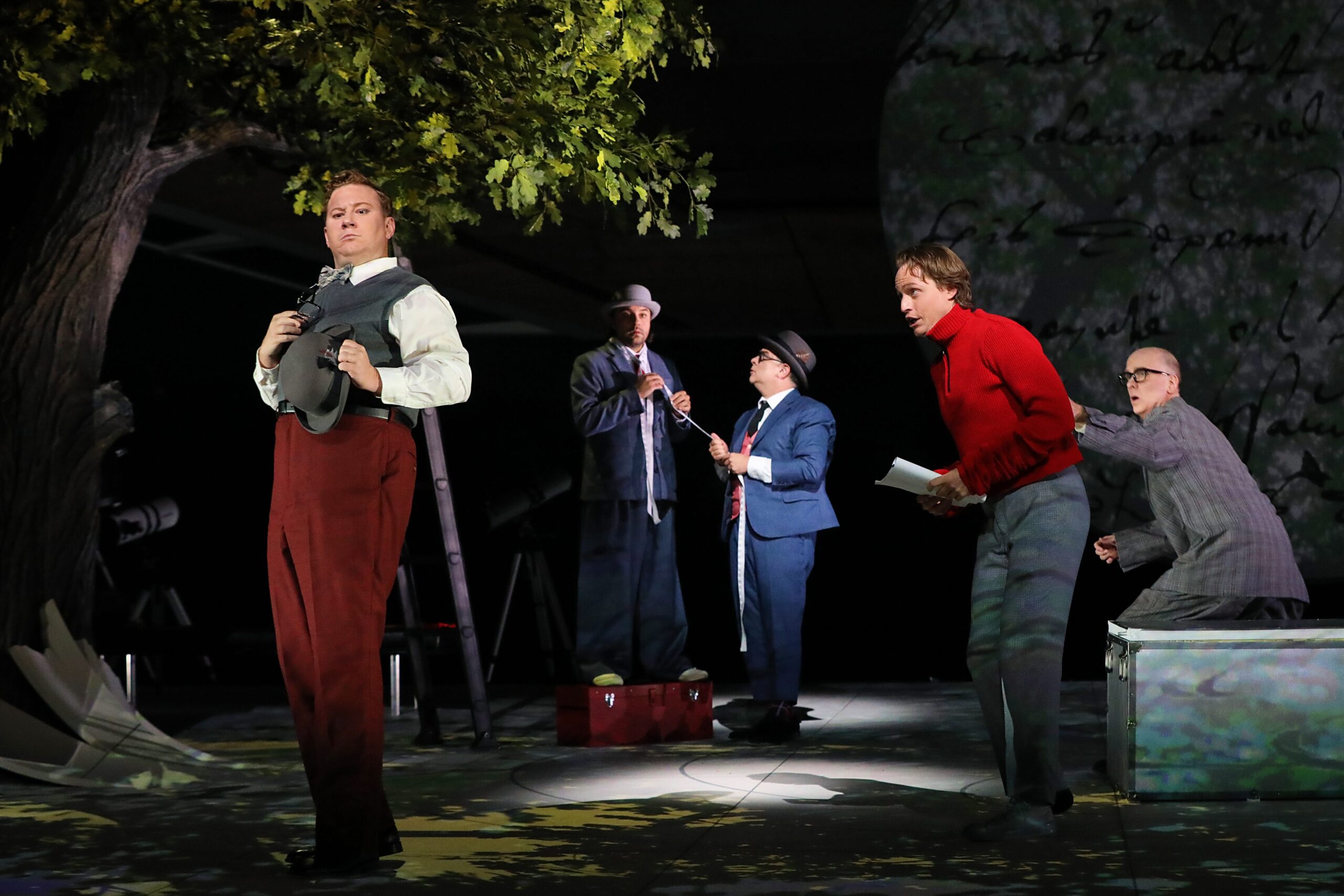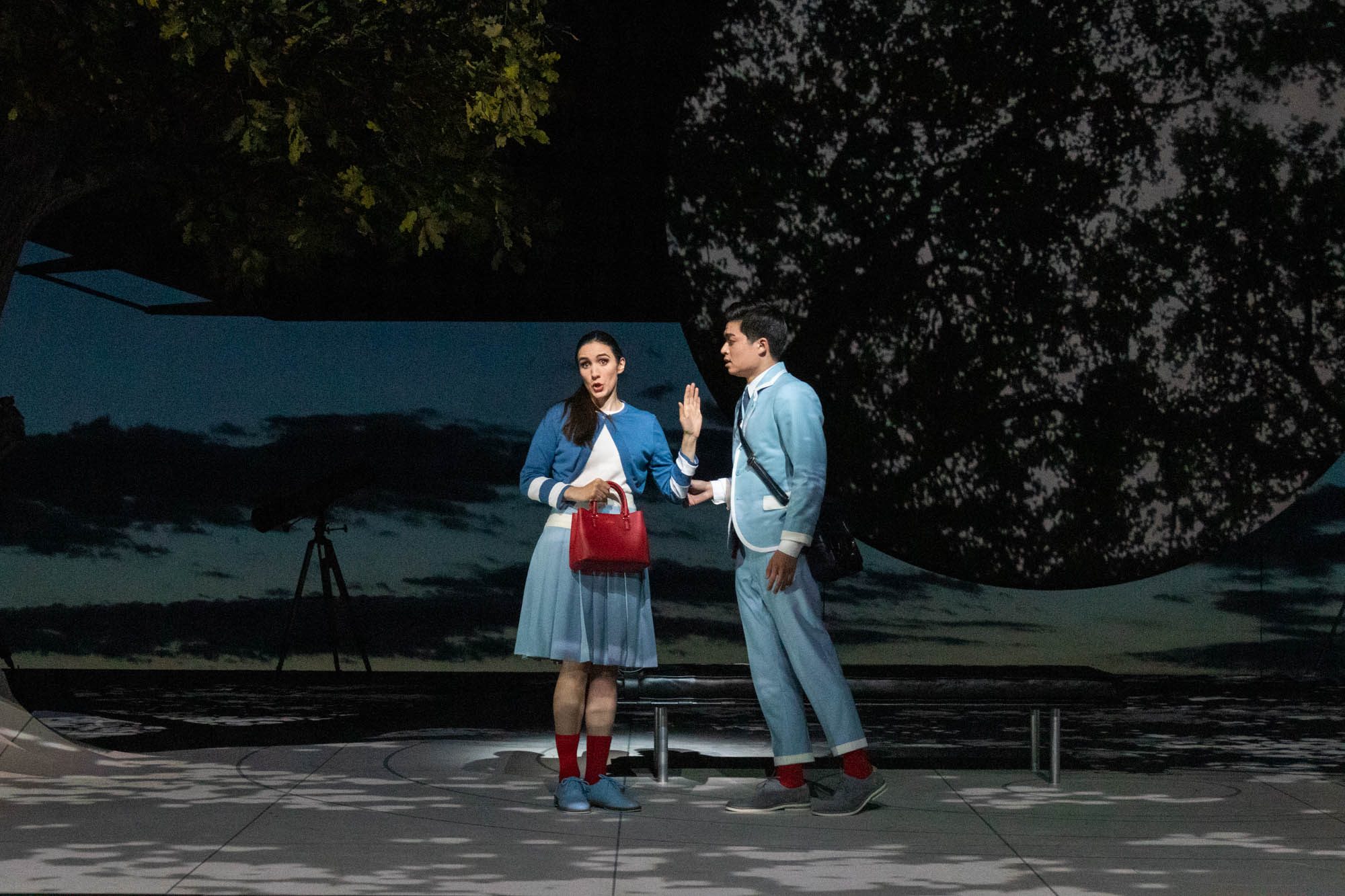If ever there was a nigh perfect match of an opera with idyllic outdoor surroundings, Santa Fe Opera’s A Midsummer Night’s Dream is surely the one.
The opening thirty minutes of this woodland tale played out against a resplendent sunset seen through the open-backed stage. The sky’s inevitable darkening took us along with the characters, deeper into the forest and the complicated plot intrigues.
Benjamin Britten and Peter Pears’ musical adaptation is based closely on Shakespeare’s popular comic fantasy, and while the Bard’s already lyrical creation did not (for me) cry out to be musicalized, the result is very enjoyable on its own terms.

Netia Jones is the tireless factotum who served with great distinction as (take a deep breath) Director, Set Designer, Costume Designer, and Projection Designer. Her raised, raked playing space is a platform that contains many visual surprises, facilitated by numerous trap doors, and sparsely dressed with a grand piano, leafy tree, telescope, and a large suspended disc/globe. These were fascinating, spare images that imparted thoughtful subtext. A few additional utilitarian pieces like a lounge, ladder, and trunk were carried on and off efficiently as needed.
Ms. Jones’ vision was darker than many a production of this classic title, heavy on colorful, often glittering effects, especially with costuming. Here the design for attire was rather muted: blacks, whites, browns and grays. In a few comic instances, women’s diaphanous trains arrived over long, and were cut and freed from the bolt of fabric in full view. The pops of color were well-calculated, never more so than with Tisbe’s garish red gown. The four lovers looked like high school children in aptly natty uniforms with subtle blue accents.
Netia’s projection design was a potent presence, making fine use of that hanging circle, with visuals constantly morphing to accent moods and underscore the text. That said, occasionally it was sometimes too bluntly literal in its imagery. As a play festival adjudicator once advised: “We can hear the words of the song, you don’t need to act them out.” The mysterious, atmospheric look of the show was superbly complemented by D. M. Wood’s lighting design, which made good use of isolated spots, patterned areas, and when called for, as in the Rude Mechanicals scenes, blessedly straight forward.

Jones the Director had a field day with the physical antics of the intertwining stories, using every possibility of movement and every corner of the space to engage and delight. She was especially adept at creating something akin to a “star entrance” for each character. The laughable first appearance of the Mechanicals, whose heads suddenly simultaneously appear, was one of my favorite sight gags in an evening chockful of them.
Reed Luplau, also the production’s outstanding Puck, choreographed the agile and committed cast to provide characterful antics with ever-changing groupings. The visual of the sea of fairies bobbing up and down in the trapdoors dotting the floor was memorably entertaining. Mr. Luplau’s own performance was marked by spot-on line readings, and about as many gravity -defying gymnastic feats as the Tokyo Olympics. The Energizer Bunny has met his equal. Fight Director Rick Sordelet kept the action effective enough but safe.
Santa Fe’s ensemble cast simply could not have been bettered. As the King and Queen of the Fairies, Erin Morley was a silver toned Tytania, perfectly paired with Iestyn Davies’ ethereal Oberon. Ms. Morley’s poised, effortlessly produced upper range perfectly conquered the challenging vocal lines. Mr. Davies started off just a little under-powered, but quickly warmed to a secure, honeyed delivery.

The total success of the four young lovers is a testament (were any needed) to the excellence of the SFO Apprentice Singers Training Program. I am not sure I have ever heard these roles performed by fresher vocalists. Boyishly handsome Duke Kim sports a gleaming, poised tenor as Lysander. Mr. Kim’s assured control, and solid declamations were well-balanced with plangent, introspective singing of the highest order. Adanya Dunn as Hermia, the object of his affection (and dis-affection and then affection again) is a cool beauty with a warm mezzo. Her lush, pleasantly dusky vocalizing easily traversed the role’s mood swings from petulant determination to whimpering defeat.
Her counterpart, Helena (in love with, but unloved as yet by Demetrius) was ably impersonated by Teresa Perrotta, whose big, sunny soprano belied the frequent hangdog presentation of this role. Ms. Perrotta suffered her indignities with secure, arching lines and melodiously amorous pleading. Luke Sutliff was a decidedly solid Demetrius, who gifted us with a bright, virile baritone. Mr. Sutliff may seem a touch uncomfortable in his own skin onstage, but that totally works for the character, and his effortless vocal delivery served him exceedingly well.

The group of Rude Mechanicals was another unified ensemble of equally stellar singing actors. Kevin Burdette’s well-traveled and much-admired bass made a welcome return to SFO as an assured Quince. Patrick Carfizzi’s Starveling was yet more deluxe casting that found the bass-baritone in refulgent voice. Nicholas Brownlee, who had nailed Mozart’s Figaro the night before, changed styles on a dime, and infused Bottom with a charismatic bass-baritone and savvy comic delivery. Flute was deliciously assumed by Brenton Ryan, his pleasing lyric tenor effectively colored to not only serve up the long-suffering bellows mender but also a yummy Tisbe in the play-within-a-play. It is not often you hear such an accomplished tenor as Matthew Grills as Snout, an assignment he lavished with wit and pliant tone. Apprentice William Meinert held his own in this august company as a doltish Snug, his rich vibrant bass easily filling the house.
Owing to COVID concerns, the children’s chorus solos were replaced successfully by highly accomplished Apprentices: Angela Yam, Leah Brzyski, Rachel Blaustein, and Taylor-Alexis Dupont. Theseus (Cory McGee) and Hippolyta (Lindsey Kate Brown) had little stage time, but when they did, they shone. Mr. McGee’s stentorian bass was evenly produced with keen musicianship. Ms. Brown’s generous dramatic mezzo was throbbing with vitality.

Sidebar: The last two performers were also Apprentice Singers, thirty-eight of whom were presented in polished showcase auditions over two mornings for opera managers. I was fortunate to attend this diverse parade of young talent. This invaluable training program is expertly helmed by Apprentice Program Director, Gayletha Nichols.
To pull together the many delights of A Midsummer Night’s Dream and tie it up with a bow, it was left to Music Director Harry Bicket who presided authoritatively in the pit. The instrumentalists responded with a virtuosic reading of Britten’s always challenging scoring. It goes without saying that the orchestral ensemble is seamlessly professional at this company, but here the soloists also have many exposed moments, all beautifully taken. Especially noteworthy were the jaunty, prankish trumpet passages, presented with tangy gusto by Matthew Ernst. The accomplished Chorus Master was Susanne Sheston.
With health protocols firmly in place, even distancing in the audience couldn’t dampen the joy of a return to shared appreciation of a live performance. And even the face masks couldn’t dampen the guffaws, and finally, the well merited cheers elicited by this winning production.
James Sohre
Benjamin Britten: A Midsummer Night’s Dream
Cobweb: Angela Yam; Mustardseed: Leah Brzyski; Peaseblossom: Rachel Blaustein; Moth: Taylor-Alexis DuPont; Puck: Reed Luplau; Tytania: Erin Morley; Oberon: Iestyn Davies; Lysander: Duke Kim; Hermia: Adanya Dunn; Demetrius: ; Helena: Teresa Perrotta; Quince: Kevin Burdette; Snug: William Meinert; Starveling: Patrick Carfizzi; Flute: Brenton Ryan; Snout: Matthew Grills; Bottom: Nicholas Brownlee; Theseus: Cory McGee; Hippolyta: Lindsay Kate Brown; Conductor: Harry Bicket; Director, Set, Costume, and Projection Design: Netia Jones; Lighting Design: D.M. Wood; Choreography: Reed Luplau; Fight Director: Rick Sordelet; Chorus Master: Susanne Sheston
Above: The set of A Midsummer Night’s Dream. Photo by Curtis Brown for the Santa Fe Opera, 2021.